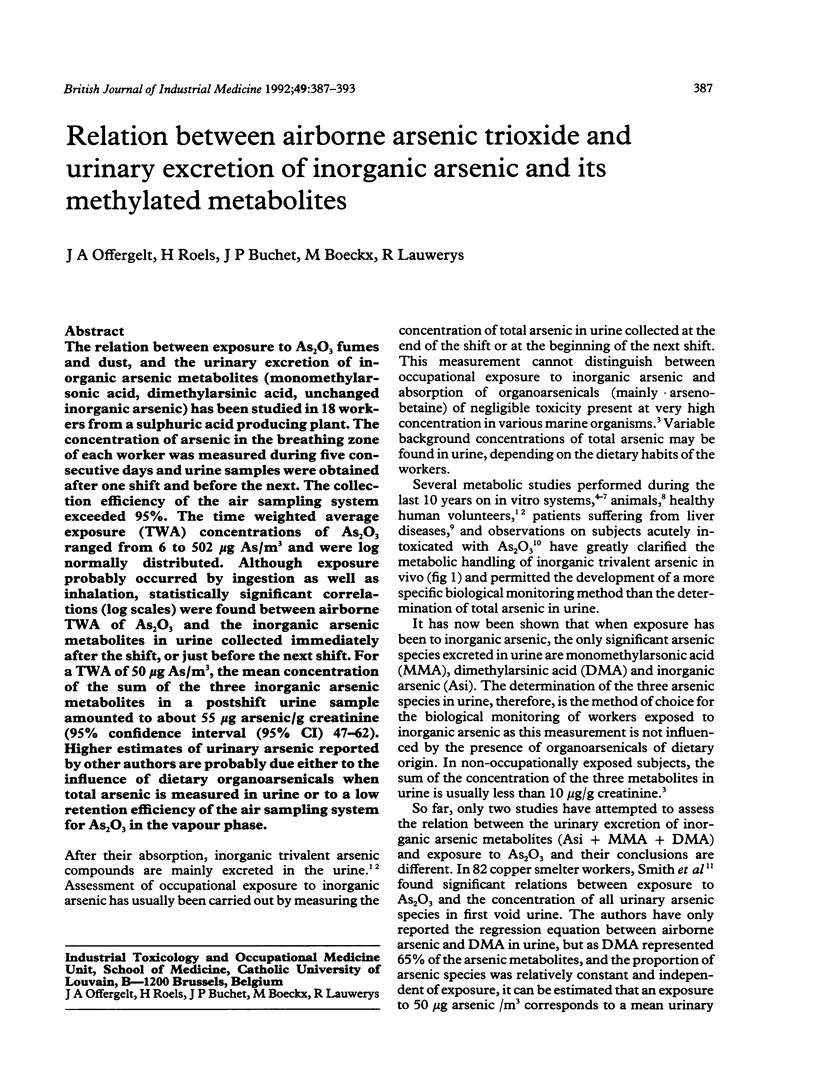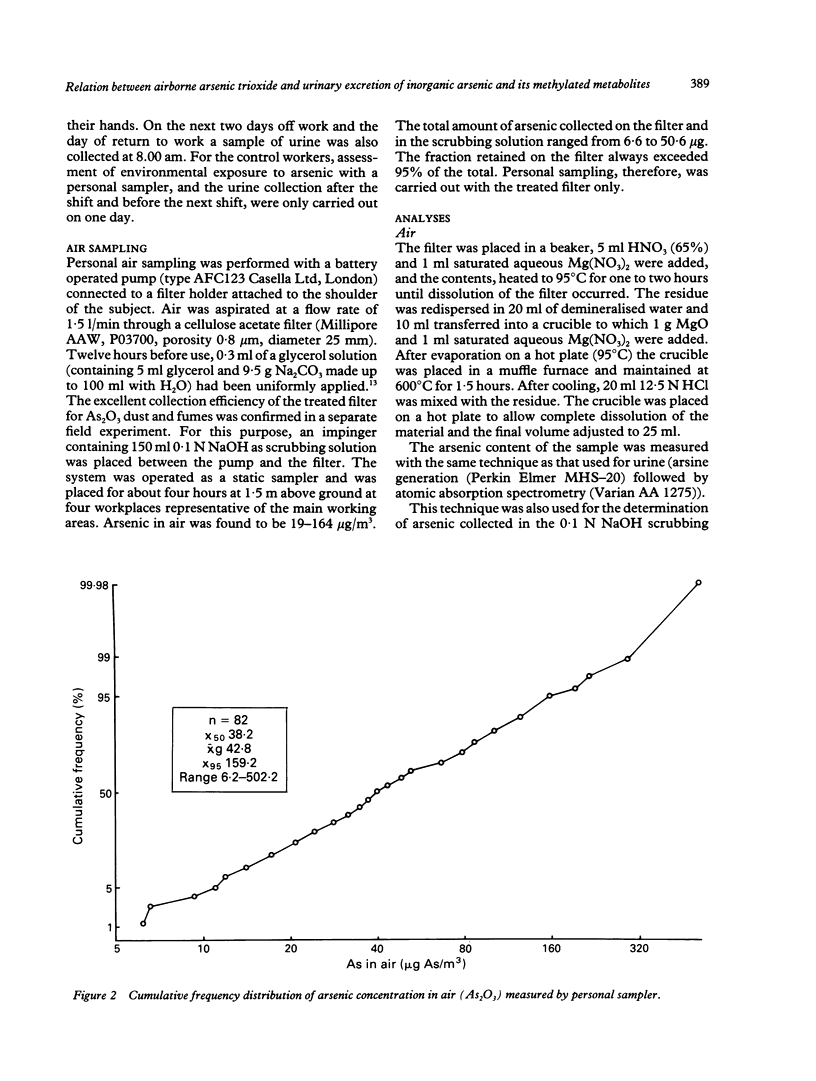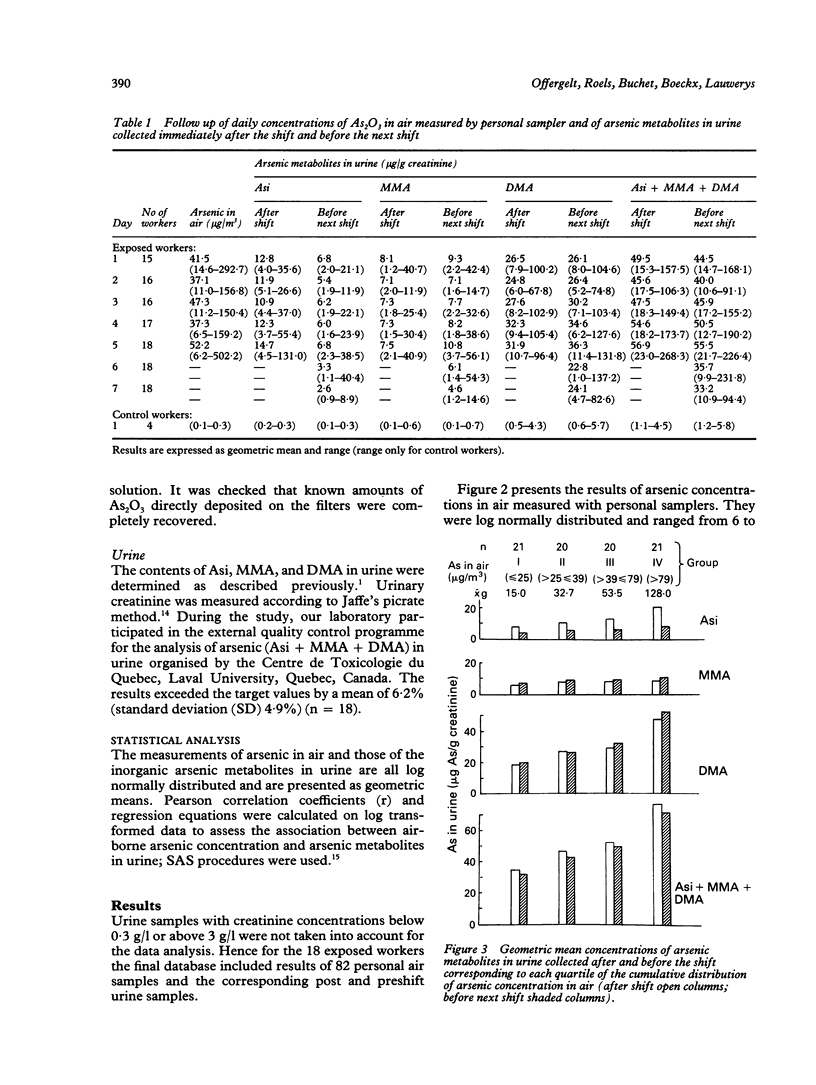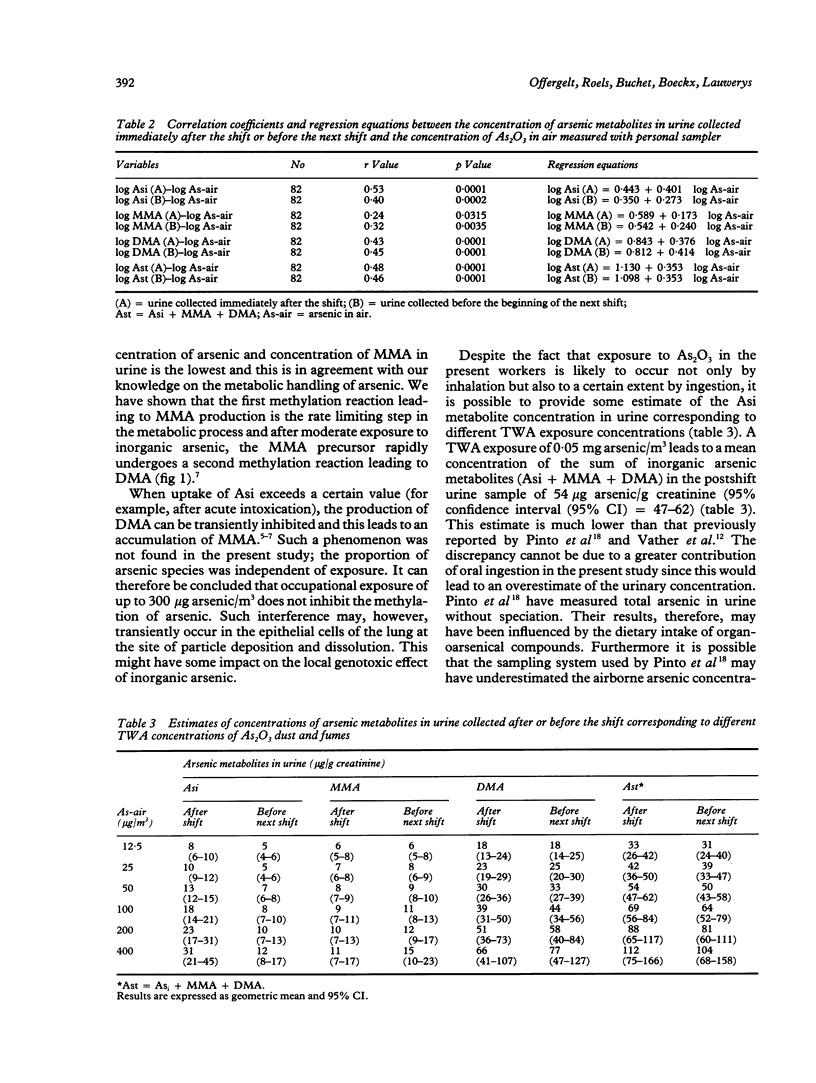Abstract
The relation between exposure to As2O3 fumes and dust, and the urinary excretion of inorganic arsenic metabolites (monomethylarsonic acid, dimethylarsinic acid, unchanged inorganic arsenic) has been studied in 18 workers from a sulphuric acid producing plant. The concentration of arsenic in the breathing zone of each worker was measured during five consecutive days and urine samples were obtained after one shift and before the next. The collection efficiency of the air sampling system exceeded 95%. The time weighted average exposure (TWA) concentrations of As2O3 ranged from 6 to 502 micrograms As/m3 and were log normally distributed. Although exposure probably occurred by ingestion as well as inhalation, statistically significant correlations (log scales) were found between airborne TWA of As2O3 and the inorganic arsenic metabolites in urine collected immediately after the shift, or just before the next shift. For a TWA of 50 micrograms As/m3, the mean concentration of the sum of the three inorganic arsenic metabolites in a postshift urine sample amounted to about 55 micrograms arsenic/g creatinine (95% confidence interval (95% CI) 47-62). Higher estimates of urinary arsenic reported by other authors are probably due either to the influence of dietary organoarsenicals when total arsenic is measured in urine or to a low retention efficiency of the air sampling system for As2O3 in the vapour phase.
Full text
PDF






Selected References
These references are in PubMed. This may not be the complete list of references from this article.
- Buchet J. P., Geubel A., Pauwels S., Mahieu P., Lauwerys R. The influence of liver disease on the methylation of arsenite in humans. Arch Toxicol. 1984 Sep;55(3):151–154. doi: 10.1007/BF00316119. [DOI] [PubMed] [Google Scholar]
- Buchet J. P., Lauwerys R., Roels H. Comparison of several methods for the determination of arsenic compounds in water and in urine. Their application for the study of arsenic metabolism and for the monitoring of workers exposed to arsenic. Int Arch Occup Environ Health. 1980;46(1):11–29. doi: 10.1007/BF00377456. [DOI] [PubMed] [Google Scholar]
- Buchet J. P., Lauwerys R., Roels H. Comparison of the urinary excretion of arsenic metabolites after a single oral dose of sodium arsenite, monomethylarsonate, or dimethylarsinate in man. Int Arch Occup Environ Health. 1981;48(1):71–79. doi: 10.1007/BF00405933. [DOI] [PubMed] [Google Scholar]
- Buchet J. P., Lauwerys R., Roels H. Urinary excretion of inorganic arsenic and its metabolites after repeated ingestion of sodium metaarsenite by volunteers. Int Arch Occup Environ Health. 1981;48(2):111–118. doi: 10.1007/BF00378431. [DOI] [PubMed] [Google Scholar]
- Buchet J. P., Lauwerys R. Role of thiols in the in-vitro methylation of inorganic arsenic by rat liver cytosol. Biochem Pharmacol. 1988 Aug 15;37(16):3149–3153. doi: 10.1016/0006-2952(88)90313-9. [DOI] [PubMed] [Google Scholar]
- Buchet J. P., Lauwerys R. Study of factors influencing the in vivo methylation of inorganic arsenic in rats. Toxicol Appl Pharmacol. 1987 Oct;91(1):65–74. doi: 10.1016/0041-008x(87)90194-3. [DOI] [PubMed] [Google Scholar]
- Buchet J. P., Lauwerys R. Study of inorganic arsenic methylation by rat liver in vitro: relevance for the interpretation of observations in man. Arch Toxicol. 1985 Jun;57(2):125–129. doi: 10.1007/BF00343122. [DOI] [PubMed] [Google Scholar]
- Fischer A. B., Buchet J. P., Lauwerys R. R. Arsenic uptake, cytotoxicity and detoxification studied in mammalian cells in culture. Arch Toxicol. 1985 Aug;57(3):168–172. doi: 10.1007/BF00290882. [DOI] [PubMed] [Google Scholar]
- Georis B., Cardenas A., Buchet J. P., Lauwerys R. Inorganic arsenic methylation by rat tissue slices. Toxicology. 1990 Jul;63(1):73–84. doi: 10.1016/0300-483x(90)90070-w. [DOI] [PubMed] [Google Scholar]
- Mahieu P., Buchet J. P., Roels H. A., Lauwerys R. The metabolism of arsenic in humans acutely intoxicated by As2O3. Its significance for the duration of BAL therapy. Clin Toxicol. 1981 Sep;18(9):1067–1075. doi: 10.3109/15563658108990336. [DOI] [PubMed] [Google Scholar]
- Pinto S. S., Varner M. O., Nelson K. W., Labbe A. L., White L. D. Arsenic trioxide absorption and excretion in industry. J Occup Med. 1976 Oct;18(10):677–680. doi: 10.1097/00043764-197610000-00009. [DOI] [PubMed] [Google Scholar]
- Roels H., Buchet J. P., Truc J., Croquet F., Lauwerys R. The possible role of direct ingestion on the overall absorption of cadmium or arsenic in workers exposed to CdO or As2O3 dust. Am J Ind Med. 1982;3(1):53–65. doi: 10.1002/ajim.4700030108. [DOI] [PubMed] [Google Scholar]
- Smith T. J., Crecelius E. A., Reading J. C. Airborne arsenic exposure and excretion of methylated arsenic compounds. Environ Health Perspect. 1977 Aug;19:89–93. doi: 10.1289/ehp.771989. [DOI] [PMC free article] [PubMed] [Google Scholar]
- Vahter M., Friberg L., Rahnster B., Nygren A., Nolinder P. Airborne arsenic and urinary excretion of metabolites of inorganic arsenic among smelter workers. Int Arch Occup Environ Health. 1986;57(2):79–91. doi: 10.1007/BF00381375. [DOI] [PubMed] [Google Scholar]


